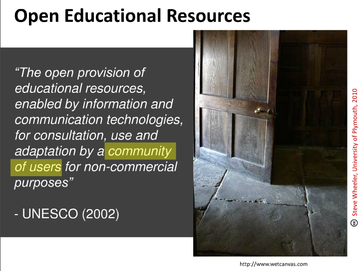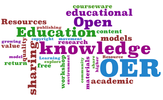OER4Ed/About
Contents
Introduction to OER:

What are OER?
There are a number of definitions that you can explore in the workshop activities under Defining OER. The first one was developed by UNESCO in 2002. As OER gained wider adoption in our formal education institutions around the world our collective understanding of the definition has also matured over the past 10 years. There is growing consensus that a definition of OER ideally needs to incorporate three interrelated dimensions:
Educational values: of freedom; Pedagogical utility: the permission to reuse, revise, remix and redistribute (the 4Rs); Technology enablers: that enable rather than restrict the 4Rs framework.
In its simplest form, the concept of OER describes any educational resources (including curriculum maps, course materials, lesson plans, assessments, readings, textbooks, videos, multimedia applications, podcasts, simulations, and any other materials that have been designed for use in teaching and learning) are openly available for use by educators and learners, without the need to pay any license fees or royalties.
Are OER the same as e-learning?
OER is not synonymous with e-learning, although many people seem to be using the terms interchangeably. OER can be produced in any medium: paper-based text, video, audio or other computer based multimedia. A lot of e-learning courses currently use OER, but this does not mean that OER are necessary e-learning. Many OER while produced and shared in a digital format are also printable.
How open is Open in OER?
Many educators assume that when they publish content on the Internet, they are doing so to share with others. While that may be true, unless the materials are licensed under open licenses, educators' freedom to share these resources is legally restricted. Openly licensed content or resources does not mean that they belong in the public domain or that the author gives up all of their rights. A broad spectrum of legal frameworks has emerged to govern how OER are licensed for use. The best know one is the Creative Commons licensing framework (CC). An author who applies a CC license to their work retains copyright over that work, but agrees to give away some of those rights. The video Creative Commons licences explained developed by Creative Commons Aotearoa New Zealand (Creative Commons Kiwi) with support from InternetNZ is a great place to start developing your understanding.
Defining and finding OER
How to define OER?
Below are two of the many definitions of OER. To explore further range of opinions on the specific requirements of what constitutes an open education resource and arrive at your own visit the Defining OER wiki page.(opens in a new window for convenience)
|
Option 1
Option 2
|
Where to find OER?
There are a number of different strategies you can deploy when searching for OER of good quality. Two of the popular and quite effective ways to find OER are to use a special search engine and a suitable OER repository based on subject, institution or media. To find more how to effectively search and find OER visit the Finding OER wiki page (opens in a new window for convenience).
How to Integrate OER into teaching and learning?
OER can be included as resource materials for learning, or created by students and teachers as part of the learning and teaching process. In principle using OER is not much different to using copyrighted materials in teaching and learning. The main reason any materials are used is because they have educational value. However, OER are different in that they allow for extra flexibility as educators and learners have the freedom/ permission to modify, mix and remix them to better meet their needs. Common ways of use and integration of OER into teaching and learning are - mixing, adaptation, remixing or extraction. There are eight steps identified to help educators with Integrating OER effectively that you may want to follow when you start adopting and integrating OER into your own practice.
Here is an example how OER hosted on WikiEducator or in a OER repository or site can be integrated and embedded into an institutional LMS. The demonstration in this particular case is in Moodle. The demo course is open and allows guest access so you do not have to create an account to view it.
If keen to extend your knowledge further visit OER Training Toolkit. It is a great web resource designed to support a self-directed, activity-based approach to understanding how open education resources (OER) can be used to support teaching and learning in open and distance learning contexts.
What skills are needed?
Educators that are embarking on the OER journey will be more successful if well equipped with:
- understanding of the pros and cons of different open licensing - OCL4Ed is a great place to start and learn about the different Creative Commons Licenses and how educators can effectively use them in their practice;
- strategies to search and source OER from main repositories, special sites and OER search engines - Finding OER wiki page provides useful information;
- knowledge how to adapt and integrate OER coherently into contextualized programmes and courses - Integrating OER outlines 8 simple steps to follow;
- technical skills similar to the skills needed to design and develop resources of resource based learning - Learning4Content is a project that you may want to get involved in to build further your capacity in developing free content for learning, and in particular wiki editing skills.

